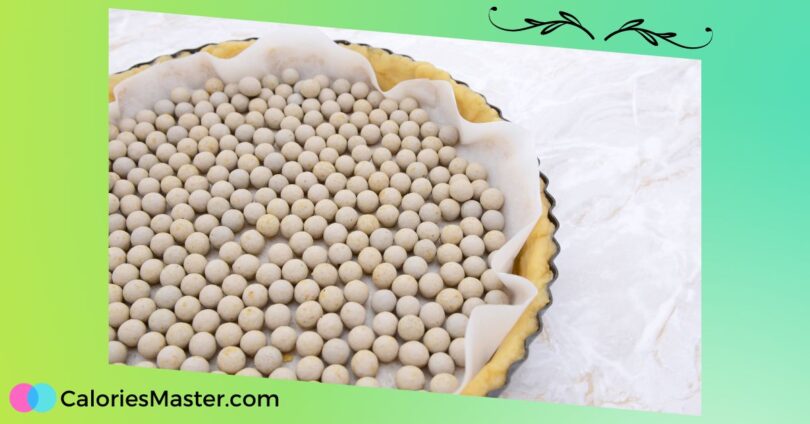When it comes to baking a pie, one of the most important steps is blind baking the crust. Blind baking means baking the crust without any filling in it, and it helps to prevent the crust from getting soggy when the filling is added later.
One of the key tools for blind baking is pie weights, which are used to weigh down the crust and prevent it from puffing up or shrinking during baking. But what can you use as pie weights if you don’t have any on hand?
Fortunately, many household items can be used as pie weights in a pinch. One common option is dried beans, which are inexpensive and readily available. Rice, lentils, and popcorn kernels can also be used as pie weights, as can ceramic or metal beads specifically designed for this purpose.
In a pinch, even coins or marbles can be used as makeshift pie weights, though it’s important to wrap them in parchment paper or a tea towel to prevent them from sticking to the crust.
Understanding Pie Weights
When it comes to baking a pie, one of the most important steps is to blind-bake the crust. Blind baking means baking the crust without the filling, and it helps ensure that the crust is fully cooked and crispy.
However, when you bake a crust without the filling, it tends to puff up and lose its shape. That’s where pie weights come in.
Pie weights are small, heat-resistant objects that you place on top of the crust to weigh it down and keep it from puffing up. There are several types of pie weights that you can use, each with its pros and cons.
Ceramic Pie Weights
Ceramic pie weights are the most traditional type of pie weights. They are small, ceramic balls that you place on top of the crust.
They are reusable and can be washed and dried for future use. Ceramic pie weights are great for pies that require a longer baking time, as they hold heat well and distribute it evenly. However, they can be heavy and difficult to handle.
Dried Beans
Dried beans are a cheap and easy alternative to ceramic pie weights. You can use any type of dried beans, such as chickpeas or black beans. Simply place a layer of parchment paper on top of the crust, then pour the dried beans on top.
Dried beans are lightweight and easy to handle, and they can be reused multiple times. However, they don’t hold heat as well as ceramic pie weights and may not distribute heat evenly.
Rice
Rice is another alternative to ceramic pie weights. Like dried beans, you can use any type of rice. Simply place a layer of parchment paper on top of the crust, then pour the rice on top.
Rice is lightweight and easy to handle, and it holds heat better than dried beans. However, like dried beans, it may not distribute heat evenly.
Metal Chain
Metal chain is a less common type of pie weight, but it can be effective. The metal chain is placed on top of the crust and held in place with parchment paper.
The metal chain is lightweight and easy to handle, and it holds heat well. However, it can be difficult to find and may be expensive.
No matter which type of pie weight you choose, it’s important to handle them carefully and remove them from the crust gently to avoid damaging the crust. With the right pie weights, you can ensure that your pie crust comes out perfectly every time.
Commercial Pie Weights
If you’re not a fan of using DIY pie weights, you can always opt for commercial pie weights. These are readily available in most baking stores and online shops. Here are the three most common types of commercial pie weights:
Ceramic Pie Weights
Ceramic pie weights are made of small, ceramic balls or beads that are designed to hold down the crust of a pie while it bakes. These are ideal for those who want to avoid using metal or glass weights. Ceramic pie weights are also reusable and can be washed and stored for future use.
Metal Pie Weights
Metal pie weights are made of small, metal balls or chains that are designed to hold down the crust of a pie while it bakes. These are ideal for those who want a more heavy-duty option. Metal pie weights are also reusable and can be washed and stored for future use.
Glass Pie Weights
Glass pie weights are made of small, glass beads that are designed to hold down the crust of a pie while it bakes. These are ideal for those who want a reusable option that is also easy to clean. Glass pie weights can also be used for blind baking, which is when you bake a crust without any filling.
When using commercial pie weights, it’s important to follow the manufacturer’s instructions carefully. Most pie weights should be placed on top of a piece of parchment paper or aluminium foil before being added to the crust. This will prevent them from sticking to the dough.
Overall, commercial pie weights are a convenient and reliable option for those who want to ensure their pie crusts bake evenly. Whether you choose ceramic, metal, or glass pie weights, you can rest assured that your pies will turn out perfectly every time.
What Can You Use as Pie Weights? Homemade
When it comes to baking pies, using pie weights is essential to prevent the crust from puffing up and losing its shape. While you can purchase pie weights from a store, you can also make your own at home using common pantry items.
Dried Beans
Dried beans are a popular choice for homemade pie weights as they are inexpensive and readily available. Simply line the bottom of your pie crust with parchment paper and fill it with dried beans. Make sure to spread them evenly to ensure the weight is distributed evenly.
Once you are done baking, let the beans cool down before storing them in an airtight container for future use.
Rice
Another option for homemade pie weights is rice. Similar to dried beans, rice is an inexpensive and effective way to keep your pie crust in shape.
To use rice as pie weights, line the bottom of your crust with parchment paper and fill it with uncooked rice. Bake as usual, and once you are done, let the rice cool down before storing it in an airtight container.
Sugar
If you want to add a touch of sweetness to your pie crust, consider using sugar as pie weights. Simply line your crust with parchment paper and fill it with granulated sugar. Once you are done baking, let the sugar cool down before storing it in an airtight container.
Keep in mind that using sugar as pie weights may cause your crust to brown more quickly, so keep an eye on it while baking.
Overall, making your homemade pie weights is a simple and cost-effective way to ensure your pie crust turns out perfectly every time. Whether you choose to use dried beans, rice, or sugar, these pantry staples can be reused multiple times and will save you money in the long run.
Alternative Pie Weights
If you don’t have pie weights, don’t worry, there are plenty of alternatives that you can use. Here are a few options:
Marbles
Marbles are a great alternative to pie weights. They are small and heavy, which makes them perfect for keeping your pie crust in shape. Simply line your pie crust with parchment paper, add the marbles, and bake as usual. Once you’re done, remove the marbles and store them for future use.
Penny Coins
Penny coins are another great alternative to pie weights. They are small, flat, and heavy, which means they will keep your pie crust in place while it bakes. To use them, simply line your pie crust with parchment paper, add the coins, and bake as usual. Once you’re done, remove the coins and store them for future use.
Baking Beads
Baking beads are specifically designed for use as pie weights. They are small, ceramic or metal beads that are perfect for keeping your pie crust in shape. To use them, simply line your pie crust with parchment paper, add the beads, and bake as usual. Once you’re done, remove the beads and store them for future use.
Overall, there are plenty of alternatives to pie weights that you can use. Whether you choose marbles, penny coins, or baking beads, you can rest assured that your pie crust will come out perfectly every time.
Choosing the Right Pie Weights
When it comes to baking pies, achieving the perfect crust is crucial. One way to ensure that your crust comes out perfectly is by using pie weights. Pie weights are used to keep the crust from puffing up and shrinking during baking.
There are several types of pie weights available in the market, and choosing the right one can make a significant difference in the outcome of your pie crust. Here are some options:
Ceramic Pie Weights
Ceramic pie weights are the most common type of pie weights. They are made of ceramic or stoneware and come in different shapes and sizes.
Ceramic pie weights are durable and reusable, making them a cost-effective option in the long run. They are also heat-resistant, which means that they can be used in high-temperature baking.
Metal Pie Weights
Metal pie weights are another popular option. They are made of stainless steel or aluminium and are available in different shapes and sizes. Metal pie weights are lightweight and easy to handle, making them a convenient option. They are also heat-resistant, making them suitable for high-temperature baking.
Dried Beans or Rice
If you don’t have pie weights on hand, you can use dried beans or rice as a substitute. Simply line your pie crust with parchment paper and fill it with dried beans or rice. They will work just as well as pie weights and are readily available in most kitchens.
In conclusion, choosing the right pie weights is essential for achieving the perfect pie crust. Whether you opt for ceramic or metal pie weights or use dried beans or rice, make sure to use them correctly to achieve the best results.
How to Use Pie Weights?
Pie weights are essential when it comes to baking pies. They help to keep the crust in place and prevent it from shrinking or puffing up during baking. Here’s how you can use pie weights to achieve a perfect crust:
- Preheat your oven to the temperature specified in your recipe.
- Roll out your pie dough and fit it into your pie dish. Trim off any excess dough.
- Prick the bottom of the crust all over with a fork. This will prevent the crust from puffing up during baking.
- Line the crust with parchment paper or aluminium foil, making sure to cover the edges as well. Make sure the paper or foil is pressed firmly against the crust.
- Fill the crust with pie weights. You can use ceramic or metal pie weights, dried beans, rice, or even coins. Make sure the weights are evenly distributed and cover the entire bottom of the crust.
- Bake the crust for the time specified in your recipe. After the first 10-15 minutes, remove the weights and the parchment paper or foil. This will allow the crust to brown evenly.
- If you’re making a pie with a filling that needs to be baked, such as pumpkin or custard, pour the filling into the crust and continue baking according to your recipe.
Using pie weights is an easy and effective way to ensure that your pie crust turns out perfectly every time. Just make sure to follow the above steps and you’ll be well on your way to baking a delicious pie!
Care and Maintenance of Pie Weights
Pie weights are an essential tool for baking pies. They help to prevent the crust from puffing up or shrinking during the baking process. Proper care and maintenance of your pie weights will ensure that they last for many years to come.
Cleaning
After using your pie weights, it’s important to clean them thoroughly. Simply rinse them with warm water and dish soap. Dry them with a clean cloth or allow them to air dry. Do not put them in the dishwasher as this may damage the weights.
Storage
When not in use, store your pie weights in a dry, cool place. A plastic bag or container with a lid is ideal for keeping them clean and dust-free. Avoid storing them in direct sunlight or near a heat source as this may cause them to warp or discolour.
Reusing
Pie weights can be reused many times. However, it’s important to inspect them before each use. If any of the weights are damaged or have cracks, they should be replaced. Using damaged weights may result in an uneven crust.
Alternatives
If you don’t have pie weights, there are several alternatives that you can use. Dry beans, rice, or even coins can be used as a substitute. Simply line the pie crust with parchment paper and fill it with the alternative weight. Be sure to use enough weight to prevent the crust from puffing up or shrinking.
By following these simple care and maintenance tips, you can ensure that your pie weights last for many years and provide you with perfectly baked pies every time.









